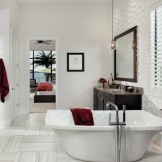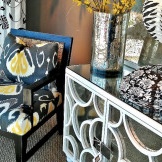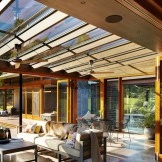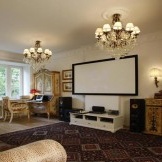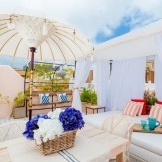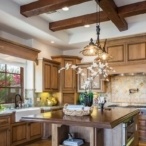Chinese interior: deep philosophy with seeming simplicity
The interior in each house performs an important function, which is not just to decorate and achieve ideal indicators from an aesthetic point of view, but is a way to achieve comfort, harmony, coziness and practicality. Therefore, when confronted with the question of choosing interior solutions, we sort through all possible options: hi-tech, rococo, fusion, minimalism, avant-garde, pop art, etc., striving to find a middle ground that will help you live in your home and experience pleasure, appeasement. This middle ground for many today is the Chinese style in the interior, which is based on the principles of simplicity, energy and nature.
History of development
At the end of the XVIII century, the traditions of Europe began to intersect with Chinese art - more and more attention was paid to the products of applied art of Chinese masters, who won attention with their exoticism and luxury. People from the upper classes of society created entire collections of expensive and mysterious Chinese porcelain, and only in 1707 D. Bettger began production of porcelain in Europe.
But the furniture art of England (mid-18th century) was more influenced by the Chinese style, he found his fan, he turned out to be the famous English furniture maker Thomas Chippendale.
It was in his works that one could observe a combination of traditional techniques with Chinese decorative lattices, planks. China became the founder of lacquer technology, while European furniture was made according to Chinese models. Not surprisingly, Russia, which is close in geographic location, even more quickly adopted Chinese traditions.
But, having become so famous in the Rococo era, the Chinese style soon succumbed to oblivion. And already today around the world an excessive interest in Chinese culture and artistic tradition has arisen, because it is China, while remaining a conservative state, that for millennia has developed sustainable customs, canons, which to this day have remained unchanged, integral. It was the worldview of the Chinese, which found its reflection in bronze casting, ceramics, porcelain and carpet products, painting, fine silk, that attracted the European man all the time.
Chinese style: distinctive features
Having carefully studied the features of the interior of Chinese dwellings, you understand that it is significantly different from the traditions of other eastern peoples. The whole reason is the search for a philosophical beginning in everything around and a peaceful way of life of the Chinese.
The interior in the Chinese style is the lack of sharp corners, overly bulky furniture, but its great variety.
The main material for the manufacture of interior items is elastic, but durable bamboo. Creating furniture, craftsmen use a complex multi-layer varnishing technique as a decorating element, and black lacquer carving remains the best way to decorate to this day.
Ceremonial furniture in the Chinese interior harmoniously combined with everyday objects - cabinets, complemented by exquisitely decorated lacquered tables, which served as a stand for luxurious vases and decorations.
The use of intarsia techniques, which is also known to Europeans, is another hallmark of Chinese furniture. In fact, the technique is a mortise decoration made of thin plywood of various colors for the surfaces of cabinets and tables. But it differs from the European one (carried out on the same level with the plane) as the Chinese - it protrudes above the surface level.The main interior items - tables, chairs, deck chairs were made of natural materials (mainly bamboo) and had a rectangular shape.
The main interior items among the furniture were a sunbed, chairs and tables. All items were made using bamboo and had mostly rectangular shapes. Another distinctive feature of the Chinese interior, which has been preserved today, is the absence of curtains and curtains on the windows.
The interior in the Chinese style is always harmony, exoticism, conciseness, all that helps to create a relaxing, cozy atmosphere.
Colors
The Chinese style is a combination of characteristic accents, therefore, such an interior not only reveals the individual characteristics, tastes and preferences of its owner, but also creates a suitable atmosphere, becomes an environment of influence and influence for each guest. Not the last role in this is played by colors that are symbolic and significant for the Chinese.
Yellow is considered the color of the emperor, the national color, green is calm, and blue is a sign of nobility, which eminent persons carefully, unobtrusively apply in the interior. Of course, the choice of a color depends on the preferences of the owners, their tastes and views.
Floors
The device of the floors is reduced in the Chinese interior to the use of large stone tiles or a massive board of light, or dark, saturated color, possibly with an unobtrusive red tint. An ideal option is bamboo flooring, as an alternative they use a mat type carpet or laminate.
In the case of using porcelain stoneware or tiles, the color scheme is selected according to the same principle as for wood - unobtrusive light / dark tones, the absence of "flashy" patterns.
Walls
The interior in the Chinese style, as a rule, implies painting or plastering the walls, but there is also room for paper wallpaper - they were invented in China. It is acceptable to use wall paintings: dwarf trees, flowering plants, birds, mountains, etc. Each drawing carries a semantic load, so you need to choose them carefully.
It is relevant to use in the decoration of walls (as a rule, this is one wall) a tree of dark species, less often - light. A successful decision is to use dark patterns made of wood, which create a sense of contrast due to the light wall. You can choose patterns to match the floor or ceiling decor.
An important point in the creation of the Chinese interior is the use of exclusively natural finishing materials.
The ceilings
Ceilings, as a rule, are made in bright colors and have a multi-level design, which allows you to create the illusion of volume and to use the backlight to simulate the light of the sun or sky.
In addition, various wooden decorative elements are often used, selected in contrast to the main tone. The ceiling often stands out in a rectangular shape, decorated with lights.
Furniture
Furniture is an important component of the Chinese interior, it is convenient and practical, made of wood using all kinds of techniques. Along with everyday furniture, decorative furniture with elements of carving, encrusting and varnishing, mainly black and red, is also actively used. Cumbersome furniture with pronounced sharp corners is not an option for the Chinese interior, here they try to avoid sharp corners and rectangular shapes as much as possible. For this purpose, use tablecloths and pillows that hide corners.
Light low sofas, bamboo chairs, lacquered stools and round tables for tea drinking - these are the main options for furniture for the interior in the Chinese style.
Cabinets are decorated using sophisticated multi-layer varnishing techniques, black lacquer carvings, and intarsia. For zoning purposes, stationary and mobile screens and screens are often used.
Cabinets are decorated with sophisticated multi-layer varnishing technique. For decoration, black lacquer carving, intarsia (mortise decoration) and inlay with mother-of-pearl, tortoise-shell or precious woods are used. For zoning, you can use painted screens and screens.
The interior decoration in the Chinese style takes place strictly according to Feng Shui, so the placement of similar interior items occurs in pairs, in a certain composition, for example, a table where identical varnished stools are located on both sides.
The Chinese are one of the exceptions among the eastern peoples - after all, they traditionally eat while sitting on a chair, and sleep on the bed.
The ideal result in creating the Chinese interior can be achieved not only with the help of Chinese-made furniture, European factories produce good analogues that can be supplemented with accessories and details and achieve the goal.
Accessories
Products from porcelain, wood and bronze, chrysanthemums, orchids and peonies, lanterns, smoking sticks, magnificent Chinese painting, satin pillows with embroidery, fancy coasters, fans, vases with hieroglyphs, dwarf trees, bamboo, candles, Chinese umbrellas - all these accessories will become unchanged companions of the Chinese style.
With their help, you can set a special mood and atmosphere in the interior, show taste and reveal the inner world.
A worthy addition to the interior will be mirrors, which are located exclusively according to the laws of Feng Shui.
Some nuances
The house in Chinese interior traditions is embodied in the prototype of Heaven - it is in unity with the garden area, thereby organizing the unity of the inner and outer world.
Special attention in the Chinese interior is paid to decorating windows and doors, their location. Often they come in quite bizarre forms.
Who will suit the Chinese style?
The Chinese style in the interior is, first of all, the choice of peaceful, traditional and extraordinary people. It is ideal for lovers of unusual solutions, conciseness, vibrant colors, lovers of philosophy in all its manifestations, including the organization of home space.
If you are a person with a refined taste, a connoisseur of rare accessories and luxurious items - you should give preference to the Chinese style!






















